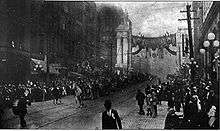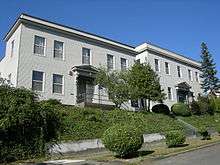History of the Japanese in Seattle
| Part of a series on |
| Ethnicity in Seattle |
|---|
|
|
|
|
There is a population of Japanese Americans and Japanese expatriates in Greater Seattle.
History

The history of the Japanese American community in Seattle can be categorized into three different periods. The "frontier period" from the 1880’s to the early 1900’s, brought a wave of immigration, consisting mostly of single males intent on amassing a fortune before returning to Japan.[1] The catalyst for this immigration was due to the Chinese Exclusion Act in 1882, which opened the door for increased Japanese immigrants to fill the labor void.[2] This first generation is known as Issei, and a majority of the men that came during this period found work in the surrounding canneries, railroad, and the massive logging industry around the Seattle area. These labor-intensive jobs did not provide the kind of rapid economic advancement they had planned on for their short three to five year stays.[3] Because a majority of the Japanese immigrants during this period had only planned to stay temporarily, the early community was unstable with a ratio of 5 men to every woman and very little social, economic, or religious support.[1] This was made worse by forced segregation and expulsions of Asians whereby Japanese people were excluded from renting or purchasing homes in West Seattle, Magnolia and other neighborhoods.[4] Long before the events of Word War II, Japanese immigrants to the Seattle area had faced considerable racism, a large portion of which was around the railroad with disputes over labor that created a divide with the predominantly white population. These tensions were exacerbated by news outlets and politics leading to petitions for Japanese exclusion and public demonstrations opposed to the import of Japanese labor.[5]

Despite this, Japanese immigrants established a Nihonmachi, or Japantown, in the International District of Seattle by the 1900’s. The Nihonmachi became the heart of the Japanese community with bathhouses, barbers, and entertainment including gambling and prostitution.[4] In July 1902 the Seattle Japanese Language School was opened under the name of Nipponjinkai Juzoku Shogakko (Elementary School Attached to the Japanese Association). At over 115 years old today, it is the oldest of its kind in the contiguous United States. The establishment of this school was followed by language schools opening in Fife in 1909 and another in Tacoma by 1911. The establishment of these schools illustrated the desire of Japanese immigrants to pass on their language and culture to later generations who they assumed would one day return to Japan. As a second generation, known as Nisei, was starting to develop, the Japanese immigrants who had once planned to return to Japan after only a few years, had begun seeing themselves as settlers.[6] Over time Japantown was developed, and Japanese became involved in the local economy. White businesspersons opposed to Japanese settlement formed the Anti-Japanese League in 1919.[7] By the 1930's the Japanese population living in Seattle had reached 8,448, out of a total population of 368,583[8] meaning that, "Japanese were Seattle’s largest non-white group, but only the fourth-largest national group behind several European nationalities."[8]
After the 1941 attack on Pearl Harbor, ethnic Japanese in Seattle were sent to concentration camps. After an initial internment at Camp Harmony in Puyallup, Washington, about 7,000 Seattle-area persons of Japanese ancestry were forced to leave the Seattle area to go to the Minidoka Relocation Center in Idaho, while another 1,000 from the Seattle area went to other camps. Members of the Japanese community lost their businesses and residences.[9] 450 students of the University of Washington were forced to leave the university due to their internment.[10]
As the war ended, residents were allowed to return, initially staying in churches, other persons' residences, and the Seattle Japanese Language School building as they recovered from the effects of internment. Japanese Seattleites who were located at Minindoka, which was renamed the "Hunt Camp," named the school the "Hunt Hotel." The Nikkei Heritage Association of Washington started the "Omoide" education program to memorialize the incarceration of the Japanese people.[11] In 2008 UW held an honorary graduation ceremony, The Long Journey Home, for the Japanese who had been their studies cut short, with 200 former students, most of whom were in their 80s at the time, and family members of former students present. Tetsuden Kashima, an ethnic studies professor of the university, presented the degrees.[10]
Geographic distribution
As of 2000 many ethnic Japanese in the Seattle area live in the Eastside region. That year 70% of the employees of the members of the Japanese business association Sunju Club, according to the organization's figures, resided in that region.[12] 7,829 ethnic Japanese reside in Seattle alone in 2010 while a total of 20,652 ethnic Japanese reside in King County alone.
Institutions
Kip Tokuda, who served as a representative in the Washington State Government, had worked to build the Japanese Cultural and Community Center of Washington (JCCCW; ワ州日本文化会館 Wa-shū Nihon Bunka Kaikan).[13]
Densho is a nonprofit organization based in Seattle, Washington, which collects video oral histories and documents regarding Japanese American internment in the United States during World War II.
Economy

By the 1930s farms owned by Japanese had produced about 75% of the produce generated in the Seattle area. This included farms in Bellevue and the White River Valley. The Pike Place Market was the point of sale of some of the produce.[7]
Early Japanese settlers worked in coal mines, canneries of salmon products, railroad construction areas, and sawmills.[7]
Uwajimaya has its headquarters in Seattle.
Media
North American Post is the region's Japanese newspaper. The company was founded in 1902 by Kiyoshi Kumamoto and investors, who were first generation Japanese immigrants (Issei) in the area. Hokubei Jiji (The North American Times) was launched on September 1, 1902, as the country’s third Japanese- American newspaper. The paper’s headquarter was located in what is today’s Nihonmachi. After the WWII began, the paper was discontinued on March 14, 1942. The newspaper published 12,278 issues over 39-and-a-half years at the center of Japanese-American immigrant communities during turbulent times. The compulsory expulsion of Nikkei during World War II had all but wiped out the Japanese American presence in Japantown. After the war, as people were released from the camps, they restarted their lives. Japanese-language media started to appear, and in June 1946, a publication that continues today, Hokubei Hochi (The North American Post), was published by Hochi Shinbun. The editor in chief was the same person who published Hokubei Jiji before the war, Sumio Arima. The publisher was the former editor of the Takoma Jijo, Sadahiko Ikoma.
Education

The Seattle Japanese School is a supplementary Japanese school, designated by the Japanese Ministry of Education (MEXT), which holds its classes in Bellevue.[14]
The Japan-America Society of the State of Washington (JASSW; ワシントン州日米協会 Washington-shū Nichibei Kyōkai) operates the Seattle Japanese Language School (JLS) in Seattle. It was established in 1902, making it the continental United States's oldest Japanese language school.[15]
Nihon Go Gakko in the pre-World War II era served as Tacoma's Japanese language school.
In the period prior to the 1940s internment of Japanese Americans, Broadway High School had the highest percentage of Japanese Americans of all Seattle high schools.[16]
Religion
Buddhist temples include Dai Bai Zan Cho Bo Zen Ji and the Seattle Buddhist Church.
Recreation
.jpg)
The oldest judo dojo in the United States is the Seattle Dojo.
The Seattle Japanese Garden is located in the Madison Park neighborhood. Kubota Garden is a Japanese garden in the Rainier Beach neighborhood of Seattle, Washington
The Nippon Kan Theatre was a former Japanese theater.
Notable residents
- Paul Chihara, composer
- Taky Kimura, martial artist
- Fujitaro Kubota, gardener and philanthropist
- William K. Nakamura, soldier and Medal of Honor recipient
- Kenjiro Nomura, artist
- John Okada, author
- Yuji Okumoto (Actor)
- Kamekichi Tokita, painter and diarist
- Kip Tokuda (Washington State representative)
- George Tsutakawa, sculptor and painter
- Minoru Yamasaki, architect
References
- 1 2 Yanagisako, Sylvia J.; Leonetti, Donna L. (1970). The Japanese American Community Study. Seattle, WA.: Dept. of Anthropology University of Washington. p. 5.
- ↑ Takami, David A. (1998). Divided Destiny: A History of Japanese Americans in Seattle. Seattle, WA: Wing Luke Asian Museum.
- ↑ Fugita, Stephen S.; Fernandez, Marilyn (2004). Altered Lives, Enduring Community: Japanese Americans Remember Their World War II Incarceration. Seattle, WA: University of Washington Press.
- 1 2 Nakaoka, Susan (2016). "THE MAKING OF A COMMUNITY WARRIOR: DONNIE CHIN AND SEATTLE'S INTERNATIONAL DISTRICT". Asian American Policy Review. 26: 57–69.
- ↑ Heuterman, Thomas H. (1995). The Burning Horse: Japanese-American Experience in the Yakima Valley, 1920-1942. Cheney, WA: Eastern Washington University Press.
- ↑ Noriko, Asato (2003). "Ousting Japanese Language Schools: Americanization and Cultural Maintenance inWashington State, 1919-1927". The Pacific Northwest Quarterly. 94 (3): 144–150 – via JSTOR.
- 1 2 3 Boswell, Sharon and Lorraine McConaghy. "Abundant dreams diverted" (Archive). The Seattle Times. June 23, 1996. Retrieved on December 21, 2014.
- 1 2 Lee, Shelley Sang–Hee (2011). Claiming the Oriental Gateway: Prewar Seattle and Japanese America. Philadelphia: Temple University Press. pp. 46–47. ISBN 978-1-4399-0215-8.
- ↑ George, Kathy. "Seattle's Japantown remembered" (Archive). Seattle Post-Intelligencer. Sunday November 21, 2004. Retrieved on April 9, 2015. "The World War II internment of Japanese Americans wiped out an entire Seattle community, forcing the 8,000 residents of "Japantown" to abandon their homes and small businesses." and "After Japan bombed Pearl Harbor in 1941, Inouye, her parents and her five siblings were among the 7,000 Seattle-area residents who were rounded up and shipped to an internment camp in Minidoka, Idaho."
- 1 2 Rolph, Amy. "Former Japanese-American students graduate UW after a 66-year wait" (Archive). Seattle Post-Intelligencer. Sunday May 18, 2008. Retrieved on April 9, 2015.
- ↑ Cohen, Aubrey. "Japanese center holds memories of Hunt Hotel" (Archive). Seattle Post-Intelligencer. Friday June 8, 2007. Retrieved on April 9, 2015.
- ↑ Vinh, Tan. " Bellevue school rolls out sushi; kids eat it up" (Archive). Seattle Times. Thursday January 27, 2000. Retrieved on April 9, 2015.
- ↑ Matsukawa, Lori (Special to the newspaper). "Guest: Kip Tokuda’s work on Seattle’s Japanese Cultural and Community Center." The Seattle Times. July 25, 2013. Retrieved on June 15, 2014.
- ↑ "ようこそ! シアトル日本語補習学校のホームページへ." Seattle Japanese School. Retrieved on June 15, 2014.
- ↑ "Seattle Japanese Language School." Japan-America Society of the State of Washington. Retrieved on June 15, 2014.
- ↑ McNerthney, Casey. "P-I archives: Former Broadway High teachers" (Archive). Seattle Post-Intelligencer. October 21, 2010.
Further reading
- Fiset, Louis. Camp Harmony: Seattle's Japanese Americans and the Puyallup Assembly Center. University of Illinois Press, 2009. ISBN 0252076729, 9780252076725. See entry - Google Books
- Lee, Shelley Sang-Hee. Claiming the Oriental Gateway: Prewar Seattle and Japanese America (Asian American History & Culture). Temple University Press, 2011. ISBN 1439902151, 9781439902158.
- Miyamoto, Shotaro Frank (1984). Social Solidarity Among the Japanese in Seattle. University of Washington Press. ISBN 978-0295961514.
- Shibazaki, Ryoichi. "Seattle and the Japanese—United States Baseball Connection, 1905-1926" (Master's Thesis). University of Washington, 1981.
- Takami, David. Divided Destiny: A History of Japanese Americans in Seattle. University of Washington Press, 1998.
- "Report on Designation Seattle Japanese Language School" (Archive). Seattle Landmarks Preservation Board.